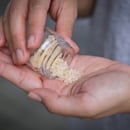
COVID-19 and Nursing Burnout
When the world began experiencing the COVID-19 pandemic, nurses stood up alongside other healthcare professionals. They began caring for these sick patients while we all tried to learn about this disease. Based on what was observed with both SARS and MERS, many believed that this pandemic would be around for a few months and then dissipate. And here we are, 18 months or so later, and nurses are still caring for COVID-19 patients. We have vaccinations, masks, and variants, as well as social discord. Yet, nurses are still caring for COVID-19 patients.
Chronic stress in the workplace that is not managed successfully creates the syndrome known as burnout. Individuals who experience burnout may experience fatigue, emotional exhaustion, cynical or negative feelings about their job, depersonalization, and reduced professional effectiveness (Di Giuseppe et al., 2021; World Health Organization, 2019). There are risk factors associated with nursing burnout, including distress (such as moral distress), sociodemographic components, decreased social support, working in a high-risk environment or critical care, lack of supplies, inadequate training, and higher workloads all contribute to causing burnout (Di Giuseppe et al., 2021; Galanis et al., 2021).
There are strategies that can be taken to help prevent nursing burnout. Organizations can create supportive environments with clear communications, decreasing workload, and providing supplies as needed. Studies have demonstrated that work environments that promote nursing professional practice can decrease burnout (de Oliviera et al., 2021). Providing a mechanism for social and peer support can assist individuals in safely expressing their emotions. Education and training regarding the care of COVID-19 patients are essential to those nurses at the forefront. Resiliency training is another strategy, including education about coping skills. Components of resiliency include a healthy lifestyle, sleep, nutrition, and the use of complementary and alternative medicine such as meditation or imagery that can provide a focus on wellness (de Oliviera et al., 2021; Di Giuseppe et al., 2021; Galanis et al., 2021).
It is important for nurses to focus on self-care during this continued tumultuous time. The ability to support one another is also essential, to get us all through. There is strength in numbers, and the nursing profession has that. Listen. Assess your co-workers for signs of distress. Use your voice to promote a healthy work environment where nurses are empowered. We can prevent burnout together.
References
de Oliveira, S. M., de Alcantara Sousa, L. V., Vieira Gadelha, M., & do Nascimento, V. B. (2019). Prevention actions of burnout syndrome in nurses: An integrating literature review. Clinical Practice and Epidemiology in Mental Health, 15, 64–73.
Di Giuseppe, M., Nepa, G., Prout, T., Albertini, F., Marcelli, S., Orru, G., & Converano, C. (2021). Stress, burnout, and resilience among healthcare workers during the COVID-19 emergency: The role of defense mechanisms. International Journal of Environmental Research and Public Health, 18(5258), 1-12.
Galanis, P., Vraka, I., Fragkou, D., Bilali, A., & Kaitelidou, D. (2021). Nurses’ burnout and associated risk factors during the COVID-19 pandemic: A systematic review and meta-analysis. Journal of Advanced Nursing, 77(8), 3286–3302.
World Health Organization. (2019). Burn-out and “occupational phenomenon”: International classification of diseases.




